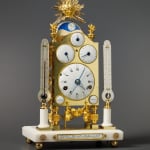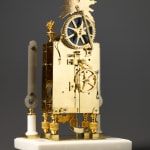
Derek Roberts, "Continental and American Skeleton Clocks", Schiffer Publishing, Ltd. 1989
Hubert Martinet
Further images
Literature
Derek Roberts, Continental and American Skeleton Clocks, Schiffer, 1989, pp. 20-21, figs. 9a, b & c.
A superb and very rare George III ormolu and white marble astronomical miniature striking skeleton clock, by Hubert Martinet
London date circa 1780
Height 34 cm
The arched gilt dial with white enamel Roman and Arabic chapter disc with pierced blued steel arrow-head hands, outer calendar ring for the months with their zodiac signs and relevant number of days, subsidiary enamel discs above for day of week, date and four seasons [Printemea/Eté/Automne/Hiver], signed at the base on two enamel disks Martinet, London, the movement with rectangular plates with four pillars and twin going barrels, anchor escapement with silk-suspended pendulum with crescent-shaped pendulum bob, the countwheel strike on a bell under the base via a vertically positioned steel rod, finely painted revolving enamel moon phase disc beneath an ormolu sunburst, twin flambeau um finials flanked by mercury and alcohol thermometers with silvered scales mounted on marble pedestals, the rectangular white marble base on ball feet, the front applied with a white enamel plaque inscribed “Let Time Fly and Make Use of It”.
The present clock was almost certainly retailed in London. Derek Roberts, Continental and American Skeleton Clocks op. at. comments on its style being typical of French products of the Louis XVI period and indeed notes that the back of the dial plate is signed by a French maker Delauney. Martinet was presumably a descendant of James Martinet whose family emigrated from France circa 1700.
The fact that Martinet worked in Paris is confirmed by his signature appearing on a distinctly French cartel clock (illustrated in Tardy, "La Pendule Française", vol 1. p.86). The duc d'Orléans also owned two of his clocks at the Palais Royal, which were seized by the Revolutionary government in 1793, one of which is probably the same as Martinet's astronomical mantle clocks now in the Musée des Arts et Metiers, Paris. The latter signed Martinet London is flanked by two marble figures while the clock itself features multi-calendar dials surmounted by a lunar dial and an Apollo sunburst. Interestingly it is identical to another of the same design signed Martinet London previously sold by this gallery (illustrated in Richard Redding Antiques", 1991, p. 56).




